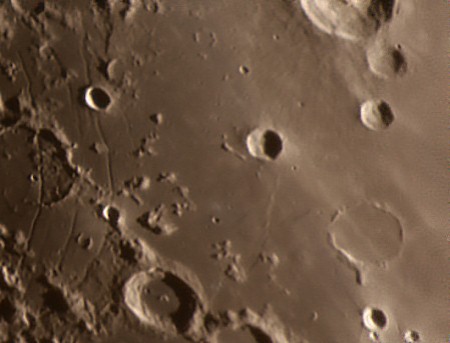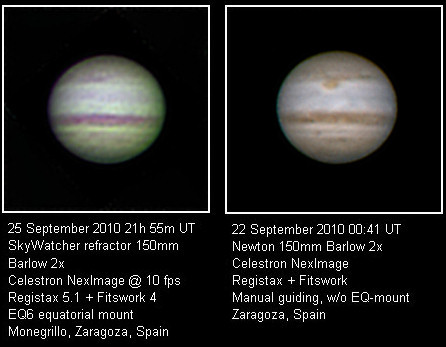Near Bullialdus crater (at top-right side of the picture) there is a quite interesting region called Rimae Hippalus. Hippalus crater is the big one (left-center side of the picture). It is a big crater. In this image, shadows in this crater due to a low altitude sunlight creates a visual effect, as if a great creature had stamped his bare footprint in lunar soil. Do you see it?
Archive for Registax
Moon scratched by the claw of a bear
Posted in Astrophotography with tags Astronomy, Astrophotography, Bullialdus crater, Canon EOS 450D, Manual-Crazy-Tracking, Meade Lightbridge 16", Moon, Newtonian, no tracking, Reflex, Registax, Rimae Hippalus, Telescope on 2011/08/31 by computerphysicslabMoons of Saturn through telescope
Posted in Astrophotography with tags Astronomy, Astrophotography, Camera, CCD, Celestron, DBK, Dione, Iapetus, Moons of Saturn, planet, planetary, Registax, Rhea, ring, satellites, Saturn, shift-and-add, solar system, stacking, Tethys on 2011/03/09 by computerphysicslabTitan, Tethys, Rhea, Dione, Iapetus are five bright moons of Saturn, the ring planet in our Solar system. They can be observed through amateur telescopes with at least 100mm (4 inches) of aperture. The following picture was taken through a 5 inch telescope, a Celestron NexStar 5 SE XLT. It is an image composed of 84 single subframes of 1 second of exposition each one.
It was taken on 2011-03-06 02h10mUT using a DBK 21AU04.AS Imaging Source CCD camera. Planet was recorded in a different exposition through a video stacked (shift and add) using Registax free software.
Check out the JPL simulation matching the picture above.
Celestron NexStar 5SE vs Takahashi FS102
Posted in Astrophotography with tags Amateur, Apochromat, Astronomy, c5, Catadioptric, Celestron NexStar 5SE, Fitswork4, fluorite, planet, refractor, Registax, Saturn, Schmidt-Cassegrain, Takahashi FS102, Telescope on 2011/02/19 by computerphysicslabThis week I had the chance to test a Takahashi FS102 refractor apochromatic fluorite telescope and also a Celestron NexStar 5SE Schmidt-Cassegrain catadioptric telescope. First one has an aperture of 102mm and second one of 125mm plus a central obstruction. Their light gathering power is similar and also their theoretical resolution. Nevertheless I wanted to check by myself the mythical optical quality of FS102 in contrast to the well-known Celestron.
Tests were made using the same camera to capture video and similar weather conditions both nights. I took in both cases a video of the planet Saturn when reaching the meridian, its maximum altitude. Celestron C5 perform flawlessly because I could get a sharp view of Saturn and its ring at 500x magnification. Takahashi also let me reach that high powers with a crisp result. C5’s focuser is very precise, but Takahashi’s is even more being a rack and pinion system. Focusing the FS 102 was very pleasant due to its smoothness and accuracy. Probably a better contrast in visual images delivered by refractor telescopes also gave it an advantage here.
Trying to resolve fine details, in both telescopes I could see the shadow of Saturn over the rings clearly. Here it is the final picture after applying Registax and Fitswork4 to both videos.
Sharing raw footage of Jupiter and Saturn
Posted in Astrophotography with tags apochromatic, Astronomy, Canon EOS 450D, fs102, Jupiter, Rebel XSi, refractor, Registax, Saturno, stacking, takahashi, Telescope on 2011/02/11 by computerphysicslabOn 2011-02-06 I took some videos of Jupiter and Saturn through a (4 inch) 102mm apochromatic refractor telescope. Applying Registax I got the results of the picture.
I’d like to share these two videos with anybody interested in playing with them:
http://www.mediafire.com/file/tqkri1z5z4pw8ge/Saturn-Takahashi-FS-102-F40-2011-02-06-divx.avi
http://www.mediafire.com/file/jbu38q5ucq9diwz/Jupiter-Takahashi-FS-102-F40-2011-02-06-divx.avi
My Jupiters at ALPO
Posted in Astrophotography with tags ALPO, image, Jupiter, picture, planet, Registax on 2010/09/28 by computerphysicslabALPO has a webpage where people around the world uses to post their best planetary images. Recently I got two pictures of picture through a Newtonian and through a refractor telescope. ALPO webpage published my pictures at these URLs:
http://alpo-j.asahikawa-med.ac.jp/kk10/j100925z.htm
http://alpo-j.asahikawa-med.ac.jp/kk10/j100922z.htm
And these are the images:
Saturn with a 6 inches refractor
Posted in Astrophotography with tags 150 mm, 6 inches refractor, achromatic, Astronomy, Casio Exilim EX-FS10, Fringe Killer, psp9, Registax, Saturn, Sky Watcher, Telescope on 2010/04/10 by computerphysicslabMare Tranquillitatis in color
Posted in Astrophotography with tags 150/750, afocal, Astronomy, Canon EOS 450D, Manual-Crazy-Tracking, Mare Serenitatis, Mare Tranquillitatis, Moon, Newtonian, Paint Shop Pro, Rebel XTi, Reflector, Registax, Telescope, terminator on 2009/09/11 by computerphysicslabColor contrasts in the Moon are interesting even beautiful. The following picture shows Mare Tranquillitatis area and the southern part of Mare Serenitatis in full color. It was taken 4 days after full moon. The shadows in the terminator show the orography of the landscape. Mare Tranquillitatis seems to be mainly blue. This is due to its peculiar chemical composition.
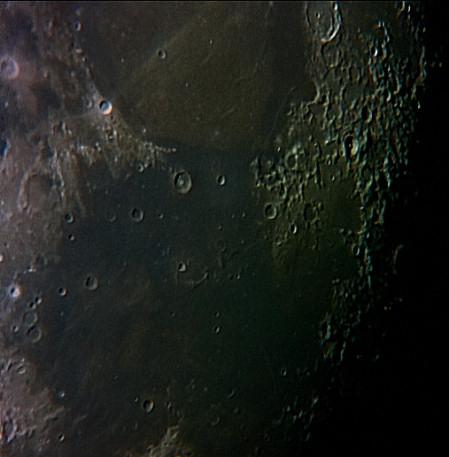
Pitiscus
Posted in Astrophotography with tags 150/750, afocal, Astronomy, Canon EOS 450D, crater, Hommel, Ideler, Manual-Crazy-Tracking, Moon, Newtonian, Noiseware, Paint Shop Pro, Pitiscus, Rebel XTi, Reflector, Reflex, Registax, Spallanzani, Telescope, terminator on 2009/09/09 by computerphysicslabPitiscus, Hommel, Ideler and Spallanzani are the only four craters of the picture with proper name. The rest of them are named by letter surnames like Ideler R or Ideler L. They are located in the South-East area of the Moon. The picture was taken on 2009-09-09 05h 20m U.T. and the terminator was passing across Pitiscus, Hommel, the two big and shadowed craters. Pitiscus is 85 km wide and Hommel is 129 km (76 miles). The smallest craters of the image are 7 km wide, that is 3.5 arcseconds, 1.75 arcseconds for the bright spot and 1.75 arcseconds for the shadow spot. Image detail could then be better for a 6-inch telescope (this is the equipment used to take the image, an scope capable up to 0.7 arcseconds of resolution). 622 subframes were recorded with the Manual-Crazy-Tracking system and stacked in Registax 5.

Jupiter, Io & Wesley impact scar
Posted in Astrophotography with tags 150/750, afocal, Astronomy, Canon EOS 450D, impact, Jupiter, Newtonian, no tracking, Paint Shop Pro, Registax, scar, shift-and-add, Telescope, Wesley on 2009/08/28 by computerphysicslabGood seeing yesterday too (2009-08-27 23h05m UT). Wesley impact scar is fading day after day, but it is still there. I made an animation that shows Io approaching Jupiter’s limb: http://www.youtube.com/watch?v=78zJtv569y4

Jupiter & 3 moons
Posted in Astrophotography with tags 150/750, afocal, Canon EOS 450D, Jupiter, Newtonian, no tracking, Registax, shift-and-add, Telescope on 2009/08/12 by computerphysicslabJust some minutes ago.
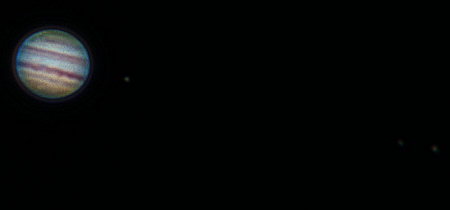
Mare Crisium & Tranquillitatis
Posted in Astrophotography with tags 150/750, afocal, Astronomy, Canon EOS 450D, Lu, Mare Crisium, Mare Tranquillitatis, Moon, Newtonian, no tracking, Paint Shop Pro, Proclus, Rebel XTi, Reflex, Registax, shift-and-add, Telescope on 2009/08/08 by computerphysicslabTwo days after full moon Mare Crisium shows a nice landscape of mountains and shadows. Some of its inner crates are visible in this picture. The small crater Swift is on the limit of visibility. The big impact called Proclus and its rays are remarkable.
To take this image I used the Canon EOS 450d, Rebel XTI DSLR camera recording video subframes and later I stacked them up with Registax 5. Some small tweaks on Paint Shop Pro 9 and ready.
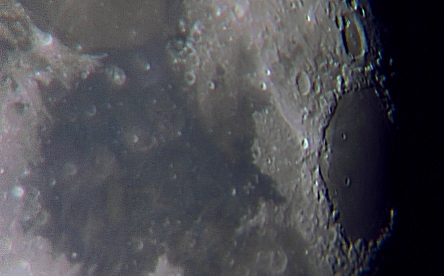
Full Moon
Posted in Astrophotography with tags 150/750, Astronomy, Canon EOS 450D, Canon EOS Rebel XTi, Full Moon, Newtonian, no tracking, Reflex, Registax, saturation, shift-and-add, Telescope on 2009/08/06 by computerphysicslabIn order to catch the Moon, I took 4 single shots at prime focus through my 150/600 telescope. As I lack of a T-mount adapter I had to take them in handheld mode. After de-rotating them accordingly, I stacked them up with Registax 5 and removed the noise a little bit. I used the body camera Canon EOS 450d (Rebel XTi) at high resolution, low sensitivity (ISO 100) and high shutter speed 1/2000. This is the result after a blow up in saturation:

Io’s shadow over Jupiter
Posted in Astrophotography with tags 150/750, afocal, Astronomy, Canon EOS 450D, Io, Jupiter, no tracking, Paint Shop Pro, Registax, shift-and-add, Telescope on 2009/08/05 by computerphysicslabAs Io passes in front of Jupiter, a big shadow is cast over the planet. In this picture I took tonight, it is clearly visible the dark point of shadow in the dead center of Jupiter. At its right a small spot that you may barely watch is Io.

In order to get a sharp image I used a Van Citter deconvolution process.
Jupiter occultation of 45 Cap
Posted in Astrophotography with tags 150/750, 45 Cap, afocal, Astronomy, Bright star, Casio Exilim EX-FS10, Jupiter, Newtonian, no tracking, occultation, Registax, shift-and-add, Telescope on 2009/08/04 by computerphysicslabJupiter occultation of 45 Cap tonight:
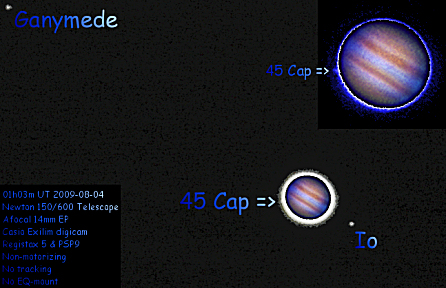
Jupiter with Exilim, 450d & Webcam
Posted in Astrophotography with tags 14mm, 150/750, afocal, Astronomy, Canon EOS 450D, Casio Exilim EX-FS10, Eyepiece, GRS, Jupiter, Newtonian, no tracking, Philips, Rebel XTi, Registax, shift-and-add, Telescope, ToUcam Pro, webcam on 2009/08/03 by computerphysicslabHere I have integrated my best images of Jupiter taken with 3 different cameras:
* Casio Exilim EX-FS10
* Canon EOS 450D (Rebel XTi)
* Webcam Philips ToUcam Pro
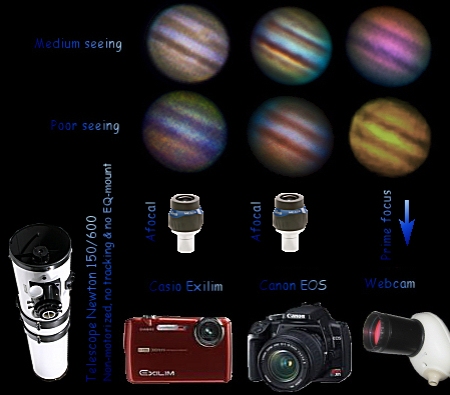
Jupiter post-processing
Posted in Astrophotography with tags afocal, Astronomy, Casio Exilim EX-FS10, good seeing, Great Red Spot, GRS, Jupiter, Newtonian, no tracking, Paint Shop Pro, Registax, shift-and-add, Telescope on 2009/07/29 by computerphysicslabI have been lucky tonight. Good seeing to see Jupiter. Using a small binoculars between the eyepiece and my eye I could spot visually Jupiter in high definition at an effective 450x magnification. That’s pretty good for a 150/600 reflector, isn’t it?
As you may appreciate in the following picture, the GRS (Great Red Spot) is clearly visible near the center of the planet. Several details are visible in the Jupiter’s bands. The image was obtained with a non-tracking Newtonian 6-inch telescope, a 14mm eyepiece, a Casio Exilim EX-FS10 digital camera that recorded 165 subframes. Registax 5 dealt with the alignment and stacking process. Dyadic Wavelets were applied to get contrast and details. PSP9 did the post-processing. The footage was taken exactly at 2009-07-28 03:33 UT.
Here several post-processing results are shown. The first one is that I like more.
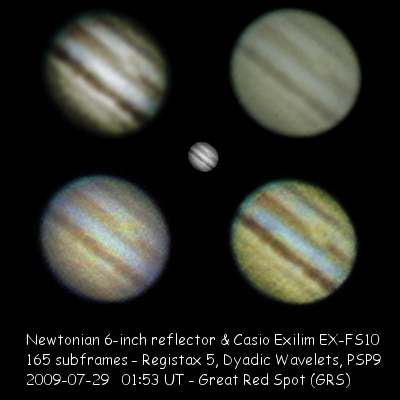
Jupiter’s galilean moons
Posted in Astrophotography with tags afocal, Callisto, Casio Exilim EX-FS10, Europa, Galilean moons, Ganymede, Io, Jupiter, no tracking, Registax, satellites, shift-and-add on 2009/07/22 by computerphysicslabGalilean moons are very easy to observe using some kind of instrument to get some magnification. With just a binoculars would be enough to spot the four moons of Jupiter. They are constantly rotating around Jupiter. Every day their relative distances and positions changes. Their names are Io, Callisto, Europa & Ganymede. They all have a similar size and brightness. When passing in front of the big planet, they cast a shadow over the gaseous surface of Jupiter. It is required a telescope to observe such events.
Here it is a picture I took tonight with a digital pocket camera through a 14mm eyepiece and a 150 mm newtonian reflector telescope with no-tracking system.
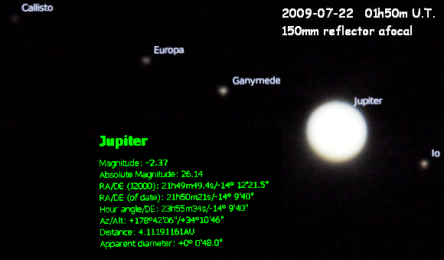
Bullialdus area
Posted in Astrophotography with tags afocal, Bullialdus, Casio Exilim EX-Z80, Meade Lightbridge 16", Moon, no tracking, Pitatus, Promontorium Taenarium, Rükl plate 53 & 54, Registax, Rupes Recta on 2009/07/18 by computerphysicslabA lot of features are located in this area of the Moon. Some of them are: Rupes Recta, Pitatus, Promontorium Taenarium, Bullialdus. It corresponds to the area covered by the Rükl plates 53 & 54.
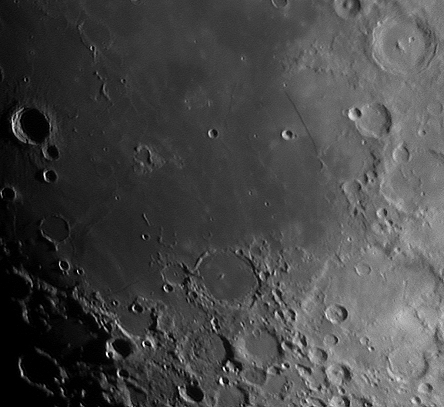
Bullialdus is the big crater at upper left side, in the shadows. Pitatus is centered in the lower side. Inside several details are visible: a peak and an inner rim. Rupus Recta is the large straight wall on the right side.
This picture was obtained after stacking (with Registax 5) 20 single frames taken with Casio Exilim pocket digital camera in afocal projection through an eyepiece using a Meade Lightbridge 16-inch dobsonian telescope.
Mare Crisium
Posted in Astrophotography with tags afocal, Casio Exilim EX-Z80, crater, Eimmart, Mare Anguis, Mare Crisium, Meade Lightbridge 16", Moon, Peirce, Picard, Registax, the serpent sea on 2009/07/03 by computerphysicslabMare Crisium is a big and round dark spot in the face of the Moon. It is easily visible through the naked eye on the right side (East) of the Moon. Inside Mare Crisium there are some interesting features, like small craters as Picard or Peirce. Proclus is the bright crater on the left (West) beyond the Crisium border. Some bright rays emerge from it crossing part of Mare Crisium. At north-east of Crisium (above right) there is a small and dark surface called Mare Anguis (the “serpent sea”). A big crater is visible at its left (West) known as crater Eimmart.
This picture was taken as the integration of 30 subframes stacked in Registax 5, from a video made with Casio Exilim EX-Z80 afocal on Meade Lightbridge 16-inches big Dobsonian, with no tracking.

A bit better Saturn
Posted in Astrophotography with tags afocal, Casio Exilim EX-FS10, Dione, Meade Lightbridge 16", no tracking, Registax, Rhea, satellite, Saturn, Telescope, Titan on 2009/05/16 by computerphysicslabFortunately, yesterday was not cloudy and I could do further experiments with Saturn. Using a Barlow 2x and Casio Exilim EX-FS10 camera I filmed some videos at highest resolution through the big dobsonian telescope Meade Lightbridge 16-inch. Weather conditions were good. I did a better collimation than previous days, getting sharp focus from time to time. Stacking the frames with Registax 5 I got this resulting image:

In the left side of the image, it is visible a satellite of Saturn. It is Titan, with 9 magnitude. Over it, a bit at right there is almost visible another one, Rhea of magnitude 10. Visually it was observable another one aligned to Titan and Rhea, but it is not visible in the image. It was Dione with 11 magnitude.
Luckily this image shows the gap between foreside ring and its rear part. The image effective resolution according to my calculations is 1 arcsecond. Two cloud bands are visible one in the north hemisphere and the other in the south.
I would like to break the 1 arcsecond resolution barrier, but I don’t know if it is possible with this telescope. Theoretically it delivers a 0.3 arcsecond resolution because it has 400mm of mirror diameter.
Proclus and surroundings
Posted in Astrophotography with tags afocal, Casio Exilim EX-Z80, Mare Crisium, Mare Tranquillitatis, Meade Lightbridge 16", no tracking, Proclus, Registax, shift-and-add on 2009/05/02 by computerphysicslabStacked from a video under Registax 5 and stitched with Autostitch, I got yesterday this Moon mosaic. Equipment: Meade Lightbridge 16″ and Casio Exilim EX-FS10.
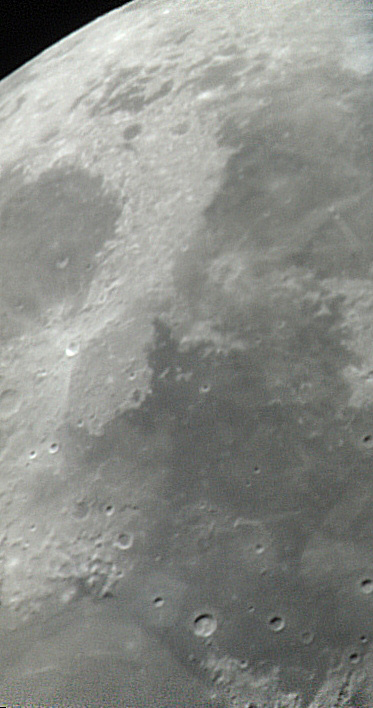
4.6 days lunation Moon
Posted in Astrophotography with tags 9Mpx, afocal, Astronomy, Binocular, Casio Exilim EX-FS10, Mare Nectaris, Mare Tranquillitatis, Moon, Registax, shift-and-add, terminator, Vixen 12x80 on 2009/04/29 by computerphysicslabTonight the Moon is crescent, and high in altitude. It is a good opportunity to record our natural satellite. Terminator is almost reaching Mare Serenitatis. Mare Nectaris (actually a gulf of Mare Tranquillitatis) is now fully illuminated and its Western border walls are clearly visible.
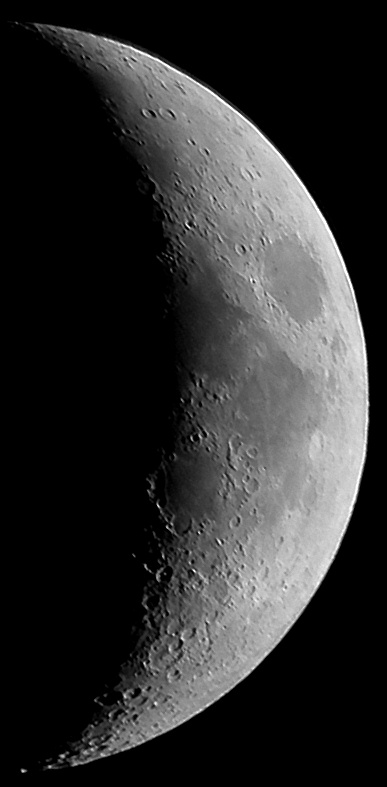
Tonight’s Moon
Posted in Astrophotography with tags 9Mpx, afocal, Binocular, Casio Exilim EX-FS10, Moon, Registax, shift-and-add, Vixen 12x80 on 2009/04/28 by computerphysicslabHere we have a 3.5 days lunation Moon. Mare Crisium is completely illuminated and some fine details may be seen, like small Swift crater (5 kms diameter). The image was a sum (Registax 5) of 10 subframes at 9Mpx using the Casio Exilim EX-FS10 and Vixen 12×80 binocular.
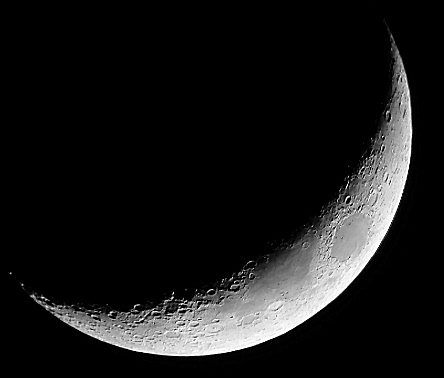
Waxing Gibbous Moon
Posted in Astrophotography with tags afocal, Binocular, Casio Exilim EX-Z80, Gibbous, Moon, Nebulosity 2, no tracking, Paint Shop Pro, phase, Registax, shift-and-add, Vixen 12x80 on 2009/04/08 by computerphysicslabYesterday’s Moon in phase waxing gibbous as seen through the Vixen 12×80 binocular, here it is. Registax 5 stacked 55 individual frames of 8 Mpx each. Nebulosity 2 was used to compensate the sideral movement and perform the de-rotation. Sharpening with Paint Shop Pro.
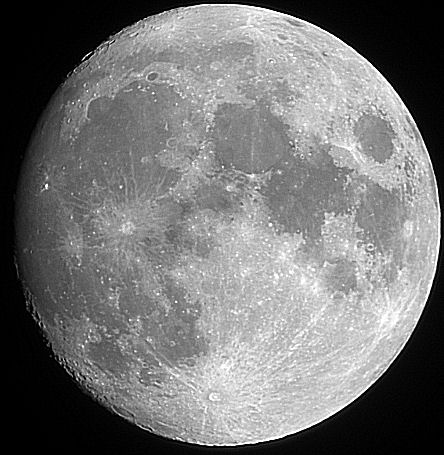
Copernicus Crater
Posted in Astrophotography with tags afocal, AutoStitch, Casio Exilim EX-Z80, lunation, Meade Lightbridge 16", Moon, no tracking, Registax, terminator on 2009/04/04 by computerphysicslabCopernicus is the name of a big Lunar crater. A video taken with the compact digital camera and the Meade Dobsonian was processed using Registax, and the resulting three frames were stitched with AutoStitch. We see here a zone in the terminator for a 9 lunation days Moon around Copernicus:
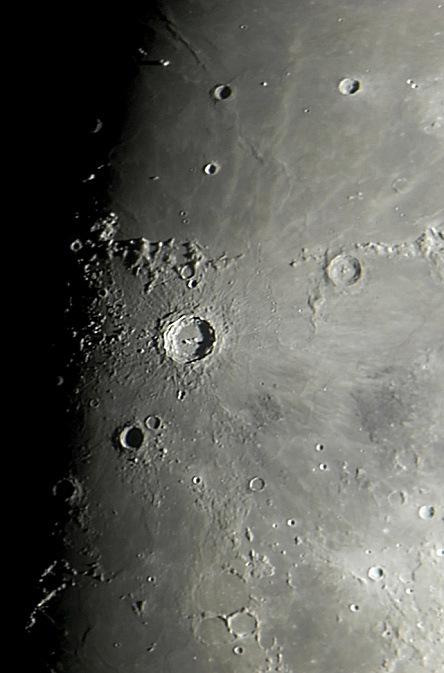
Tycho and the South Pole
Posted in Astrophotography with tags afocal, Casio Exilim EX-Z80, Clavius, Dob, Meade Lightbridge 16", Moon, non-motorized, Paint Shop Pro, Registax, shift-and-add, South Pole, Telescope, terminator, Tycho on 2009/04/04 by computerphysicslabA sequence of shots to the Moon taken with the Dob Meade Lightbridge 16″ telescope has been integrated into one final image, thanks again to Registax and Paint Shop Pro. This mosaic of Tycho crater and the South Pole region is composed of 30 individual frames. The biggest crater in the terminator is Clavius. Inside it there a lot of small craters.
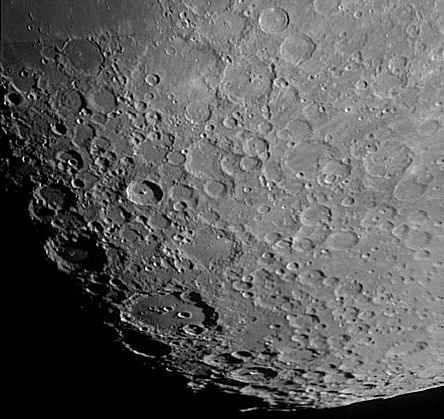
55 frames stacked in Registax
Posted in Astrophotography with tags afocal, Binocular, Casio Exilim EX-Z80, Moon, Registax, Vixen 12x80 on 2009/04/02 by computerphysicslabAfter stacking 55 frames of yesterday’s Crescent Moon, forcing a bit the saturation, and sharpening using the finest wavelet available, I am proud to introduce this Moon picture:
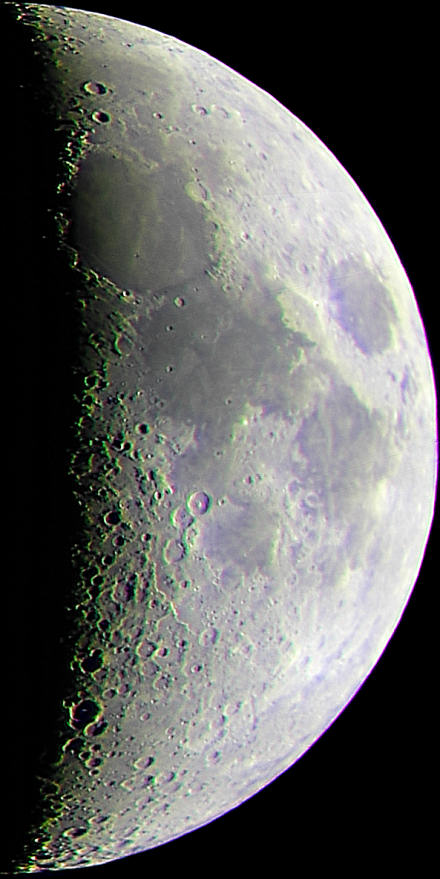
Astrophotography Software
Posted in Astrophotography with tags Adobe Premiere, AstroArt, astrophotography software, DeepSkyStacker, EasyBMPtoAVI, Google Earth, Maximum entropy deconvolution, Neat Image, Nebulosity, onOne Genuine Fractals, Paint Shop Pro, PhotoAcute Studio, Photoshop, Registax, StarryNight, Stellarium, VirtualDub, WikiSky on 2009/03/20 by computerphysicslabIt is important to apply the best astronomical software to enhance your pictures. Otherwise noise, blur, light pollution, hot and cold pixels and low exposures can degrade our work. Here is a list of my favorite astrophotography software:
* Image Stacking: Registax, PhotoAcute Studio, Nebulosity and DeepSkyStacker.
* Retouching: Paint Shop Pro and Photoshop.
* Zooming: onOne Genuine Fractals.
* Sharpening: Maximum entropy deconvolution with AstroArt, and wavelets with Registax.
* Noise removal: Neat Image.
* Video edition: VirtualDub, Adobe Premiere and EasyBMPtoAVI.
* Night sky renderers: Stellarium, StarryNight, Google Earth & WikiSky.
Saturn and rings
Posted in Astrophotography with tags Binocular, edge-on, planet, Registax, rings, Saturn, Vixen 12x80 on 2009/03/18 by computerphysicslabSaturn is well placed these nights to be easily observed. The rings are edge-on, so they are difficult to capture with photography. Nevertheless I have got a series of shots and have stacked them all with Registax 5. Take into account I have used the Vixen 12×80 binocular to get this image. Imagine seeing Saturn rings edge-on with a magnification of only 12 …

Almost Full Moon
Posted in Astrophotography with tags afocal, Binocular, Casio Exilim EX-Z80, Full Moon, Moon, Registax, Vixen 12x80 on 2009/03/10 by computerphysicslabHere we see a 13 days lunation Moon, almost full. Registax 5 did the work of stacking and wavelets. Focus was not perfect but wavelets fixed it. I multiplied the red channel to the green channel in order to enhance the image contrast.

